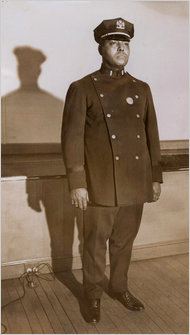Recalling First Black Appointed to New York Police Dept.

His parents were among the last generation born into Southern slavery, and his own birth in 1883 was notable for another benchmark: At 16 pounds, he was the biggest baby ever recorded in North Carolina.
“I guess I’ve always wanted to be large, and I have been large,” Samuel Jesse Battle recalled decades later.
But his personal growth was threatened when, as a teenager, he was caught pilfering cash from a safe belonging to his boss, R. H. Smith, a landlord who predicted that within a year, the young man would be in prison.
“That was the turning point of my life,” said Battle, who avoided prosecution because the boss was a friend of his father, a Methodist minister. “I said, ‘From this day on, I shall always be honest and honorable, and I’m going to make Mr. Smith out a liar.’ ”
On June 28, 1911, a century ago Tuesday, Samuel Battle largely delivered on his resolutions. Having grown to 6-foot-3 and 285 pounds, he became the first black person appointed to the New York City police force. He would go on to become the first black sergeant, in 1926; the first black lieutenant, in 1935; and the city’s first black parole commissioner, in 1941.
In 1911, the city’s population was about 2 percent black, and a number of black officers were already on patrol in Brooklyn, including Battle’s brother-in-law and mentor, Moses Cobb, but they had been hired by the City of Brooklyn before it merged with New York in 1898. The Police Department considers Wiley G. Overton, sworn in by Brooklyn in 1891, as the city’s pioneer black officer.
But Battle was the first black person appointed to New York’s combined 10,000-member force, ranking 199th of 638 applicants on the police test. The department will mark his appointment on Tuesday during Cadet Corps graduation ceremonies.
What a difference a century makes. Today, blacks are 23 percent of the city’s population, and 18 percent of all police officers. Black, Hispanic and Asian New Yorkers make up nearly 48 percent among all ranks, and among police officers they have been a majority since 2006.
Among higher-ranking officers, promoted on the basis of competitive civil service tests, minorities constitute 39 percent of sergeants, up from 19 percent a decade ago; 25 percent of lieutenants, up from 13 percent; and 17 percent of captains, up from 5 percent. Of the 43 blacks who have passed the test for captain since then, nearly half have been promoted to higher ranks.
Samuel Battle (he hated being called Sam; “every Tom, Dick and Harry who shines shoes, they used to call him Sam,” he said) moved to New York for good in 1901. He was hired as a houseboy at the Sagamore Hotel at Lake George — which, he recalled, did not admit Jews — and as a $32-a-month red cap at Grand Central Terminal. For most of his career, he lived in Harlem.
He considered working for the Post Office or the Customs Service, but decided on the police force because, he said, “it would be a permanent place in which I could support my wife and family without worry.”
When he applied, Battle was rejected by police surgeons, supposedly because of a heart murmur, but he passed a medical retest after prominent blacks protested to city officials. He suffered the silent treatment from fellow officers at his West 68th Street station house. A threatening note with a racial epithet and a hole the width of a bullet was left on his bunk.
In an interview with the Columbia University Center for Oral History in 1960, six years before he died, Battle recalled that he never complained to outsiders about his treatment from co-workers. If a colleague had something against him, Battle challenged him to meet in the cellar and “take it out on my black behind.” Nobody did.
His comrades were won over in 1919, when Battle dashed into a crowd of rioters at West 135th Street and Lenox Avenue to rescue a white officer singlehandedly. “The white officers worked in an all-Negro neighborhood, practically, and they needed me as much as I needed them and sometimes more,” Battle recalled.
Continue reading http://www.nytimes.com/2011/06/27/nyregion/recalling-samuel-battle-who-became-first-black-on-nypd.html?pagewanted=2